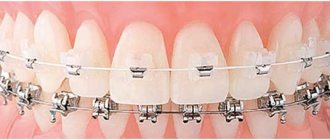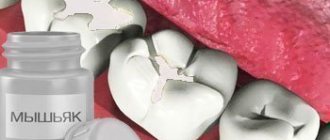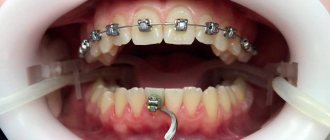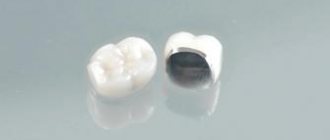Reasons why a dental bridge may fall off
The integrity of the dental bridge is influenced by the following factors:
- The bridge was made to inaccurate measurements. Dentists believe that a bridge can only be made for five crowns and no more, otherwise the bridge design becomes unreliable.
- If the neighboring teeth that support the bridge are poorly prepared for prosthetics, this can also cause the bridge to fly off.
- Crowns for supporting teeth must be made of high-quality material, and they must be fixed with high-quality dental cement.
- Improper oral and dental hygiene. To keep your artificial teeth clean, you should have your teeth professionally cleaned twice a year. If this is not done, the period of wearing dentures will be greatly reduced.
The crown constantly falls off... or what causes bridges to fall?
I once already talked about what dental crowns are, why and what they are made of. Now life itself has thrown up a new question related to this topic.
One of the heroines of one of the Russian classics liked to ask the question “why don’t people fly like birds?” A patient approached me with almost the same question just yesterday. What worried him was not the lack of flying skills among people, but the presence of such skills near his relatively new bridge. Moreover, over the course of a year, the orthopedic product tried to fly away from its owner as many as 8 (!!!) times.
Why does it happen that crowns and bridges can fall out at the most inopportune moment? Yes, and several times in a row within a short time.
It seemed to the patient (let's call him Ivan) that the whole problem was in the cement. He complained that “at the clinic they always build a bridge for me using some bad Soviet cement.” And he asked to use “some modern super cement.” And this, I must say, is a common misconception. Of course, fixing cement plays a role in the stability of crowns on teeth, but it is certainly not paramount. What then does it have? Why do crowns fly off teeth ? This question from Ivan formed the basis of this note.
I will try not to go into the jungle of orthopedic dentistry, but there is no way to do this without a little theory. The main thing that keeps the crown on the tooth is mechanical retention. That is, simply put, the tooth and crown must have certain geometric parameters so that the second never spontaneously falls off the first. Well, the inside of the crown should repeat the shape of the tooth stump as accurately as possible (this largely depends on the dental technician). To make the answer clearer, I had to draw a little for Ivan.
In the pictures below, a certain figure symbolizing a crown is depicted in red/orange, and a tooth is depicted in black. The first figure shows the dependence of crown stability on tooth height. The higher it is, the better the crown will be fixed on it. This is especially important for counteracting lateral loads (when we move three teeth left and right). I think you can easily imagine which of these black “teeth” the crown will fly off faster if we press back and forth on it from the side.
The second figure shows the dependence of crown stability on tooth taper.
I think each of us in kindergarten drew the roof of a house or a Christmas tree. Probably something like this:
Some of us grew up and, unfortunately for society, became dentists. Now they continue to make roofs for houses and Christmas trees from the teeth of their patients. The more a ground tooth looks like this...
...the less chance the crown has to stay on it. So Ivan’s several “Christmas trees” quickly turned into “stumps”. On the contrary, the more parallel the walls of a ground tooth are, the more difficult it is for the crown to fly off it. This parameter is most important for vertical loads, i.e. when we chew and move our jaw up and down. Based on these two points, an ideally ground tooth should have approximately this shape.
The tooth stump should be high enough and have almost parallel walls. The crown of such a tooth can be cemented with atmospheric air. Those. Even without any cement, the crown will not be so easy to remove. Which sometimes happens at fittings. If, at the fitting stage, the crown literally falls off the tooth and does not hold on without holding it with your fingers, then this is usually a bad sign. Conclusion! The correct geometry of the stump is the cornerstone of the reliability of prosthetics. That is why in such a seemingly simple task as preparing a tooth for a crown, the doctor’s manual skill is very important. Trimming a tooth correctly is quite painstaking work.
In addition to the correct geometric shape of the tooth ground for a crown, the exact correspondence of the inner surface of the crown and the stump is also important. There should be a minimum gap between them. Especially in the ledge area. To do this, the doctor must make a very clear and neat “step”-ledge on the tooth...
... and the dental technician must no less accurately and accurately adjust the edge of the crown to this “step” with a minimum gap. This gap will need to be filled with cement. Moreover, the smaller the gap and the smaller the cement layer, the longer-term the positive prognosis will be. That is why now the most “advanced” orthopedists grind teeth under magnification (in binoculars or even under a microscope).
What about “imported super cement”? It turns out that he is not important at all? Of course it is important. But not in the first place. In fact, the main role of cement is to seal the gap, and nothing more. It does not possess any other miraculous properties. And if the tooth is prepared incorrectly for prosthetics, then even the most wonderful “imported composition” will not help to retain the crown for a long time. That is why Ivan, who unwillingly became an aircraft tester, will have to rebuild the teeth that were mercilessly cut off by the “house” and make new crowns. But dentists who manufacture such bridges with high flight characteristics clearly need to change their profession. Such specialists may well be useful in some Sukhoi design bureau.
If they force something to fly regularly that should not fly at all, then they may well be able to raise our aviation industry to unprecedented heights.
What to do when a dental bridge has already fallen off?
The best way out of this situation is to see a dentist as soon as possible. When visiting a doctor, you must bring your saved prosthesis, even if it is cracked in half. You should not repair the bridge yourself using various adhesives that can damage healthy teeth.
If the bridge did not break when it fell out, it will be put back in place using dental cement. If the denture breaks, an impression of the patient's teeth will be taken and a dental technician will make a new denture, which will require additional costs and a long time.
How to remove crowns
The procedure for removing dental appliances is the responsibility of orthopedists and endodontists. Doctors have various techniques for removing dental structures at their disposal.
- Cutting the prosthesis using a bur
Traditional method of removing a single prosthesis. The artificial material is sawn and removed from the oral cavity. The procedure must be performed by a qualified and experienced physician. The method is suitable for dismantling budget or damaged models.
- Dismantling using ultrasound
Fast and safe removal method. Under the direct influence of ultrasonic waves on the composition, the binder material is destroyed. The product is removed undamaged. The method is suitable for models made of low-density materials.
- Manual crown remover
The work is performed using a special tool with metal hooks attached to the end. The dentist carefully hooks the edges of the dental device and removes it.
- Application of the Koch apparatus
Externally, the device looks like a crown remover. The product is equipped with a hook at the end and an activation button that provides mechanical action to destroy the cement. After the prosthesis becomes mobile, the doctor removes it with forceps.
- Coronaflex
The appearance of the device resembles a pistol. The device contains compressed air, which, after activation, flows out under high pressure. Under the influence of an air jet, the cement base of the crown is destroyed. The prosthesis and mucous membrane are not damaged.
This method applies to modern and expensive dental procedures. The method is suitable for removing expensive prosthetic models.
Metal-ceramic dental bridge - indications for installation
This type of prosthesis is designed to restore a fragment of the dentition (usually from one to four teeth). It is already difficult to use a dental bridge for 5 teeth made of metal-ceramics, since to attach a classic prosthesis, two supporting crowns are added, which are placed on natural teeth. A dental bridge made of metal ceramics can be installed on 4 teeth. However, the best option is to replace two or three teeth: in this case, good functionality is ensured and some of the disadvantages of metal-ceramic dentures, which are described below, can be hidden. Despite the fact that metal-ceramic structures are in great demand, they have a number of contraindications that exclude or limit their use.
Contraindications:
- allergy to metal
- the patient has gum disease (even in remission)
- diabetes mellitus and other diseases that require the use of bioinert materials for prosthetics
- high aesthetic expectations on the part of the patient
- other contraindications to the installation of bridges of any type (oral diseases, bruxism, mental illness, serious malocclusion pathologies, and so on)
Causes of crown loss
When restoring a tooth, the doctor makes a special crown, which is placed on the stump or a pre-ground support. Dental cement or glue is used for fixation. It can withstand biting pressure and the hot temperature of drinks. But after several years of active use, the cementing composition begins to weaken its grip, so the prosthesis wobbles and slips.
What to do if you swallow a tooth crown
The crown is a small prosthesis, so it is easy to swallow it undetected. But many patients mistakenly underestimate its health dangers. Sometimes a temporary filling with arsenic remains under it, which can damage the stomach and poison the patient.
If a person has swallowed a denture, in most cases doctors recommend waiting until it is excreted in the feces. Each patient’s body and intestines “work” individually, so complete passage through the tract can take up to 7 days.
Promptly contact a specialist
Materials used for prosthetics are not digested by the human digestive system. But when using cheap acrylic or metal, an allergic reaction often occurs. Therefore, there is always a risk of complications and unpleasant consequences.
Gastric lavage
The procedure is performed if the patient has eaten a miniature prosthesis or one crown. It is recommended only for 2–4 hours after swallowing, when the structure still remains in the stomach. It is better to entrust the washing to a specialist who controls the process using equipment, and in case of an emergency, sends it to surgery.
Possible complications after swallowing a crown
If it enters the stomach or intestines, perforation of the mucosal walls may occur. You should consult a doctor immediately if symptoms appear:
- blood in saliva or urine;
- nausea;
- excessive salivation;
- abdominal pain;
- temperature increase.
Observation is required if the prosthesis comes out naturally. Intestinal perforation can occur at any time.
If a child swallows a tooth
In the period from 6 to 11 years, active replacement of primary teeth with molars occurs. They fall out painlessly, so a situation often arises when a baby eats a molar while swallowing food. Parents should not panic: they do not have sharp edges or roots.
A hearty lunch - as a solution to the problem of a swallowed prosthesis
To ensure tooth extraction naturally, doctors recommend feeding your baby foods that stimulate the intestines. If your child has swallowed an incisor, make him oatmeal with some pieces of prunes added. Beet salad, fermented milk products and sweet yogurt improve and speed up the process.
Prevention helps to prevent tooth swallowing. When brushing every day, you should inspect your mouth to look for chips or cracks. Every 6 months you should visit a dentist who checks the condition of the crown and prosthesis, the quality of cement or clasps.
Video - what happens if you swallow a tooth or denture
Is it possible to cure a tooth without removing the crown?
The question is very relevant, because usually, after removing a structure, it can rarely be reused for its intended purpose, therefore, you have to pay money for the manufacture and installation of a new prosthesis. Fortunately, today in some cases you can do without removing the structure. For example, if it is necessary to cure recurrent caries or remove a small cyst, the doctor may perform endodontic manipulations through a small hole made in the crown or through an incision in the gum (to remove the cyst). After the procedures, this hole will be masked with a composite material, and the sutured gum will need time to heal.
In some cases, modern technologies make it possible to cure a tooth without removing the crown.
However, you need to understand that in order to safely and effectively carry out such jewelry manipulations, the doctor must be a professional. In addition, the patient himself should seek help when the problem is still minor and the inflammatory process has not gone too far. To do this, it is necessary to undergo preventive examinations, because the more minor the problem, the easier it is to solve it with therapeutic methods, without resorting to drastic measures.
Notice
: Undefined variable: post_id in
/home/c/ch75405/public_html/wp-content/themes/UltraSmile/single-item.php
on line
45 Notice
: Undefined variable: full in
/home/c/ch75405/public_html/wp-content /themes/UltraSmile/single-item.php
on line
46
Rate this article:
( 6 ratings, average: 5.00 out of 5)
crown
- Lutskaya I.K., Zinovenko O.G. Frequency of development of caries in teeth covered with artificial crowns.
How long will it take for the prosthesis to come out naturally?
If the doctor, using an x-ray examination, has determined that the swallowed prosthesis does not pose a danger, the patient can only wait. and the foreign body should come out naturally. This time may vary depending on the characteristics of a particular organism, proper nutrition, and the presence of chronic diseases of the digestive system.
If after the specified period of time the crown has not come out, it is worth undergoing a repeat X-ray examination. This will ensure that the object is not stuck and is moving through the intestines.











